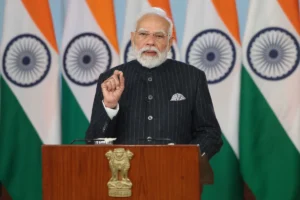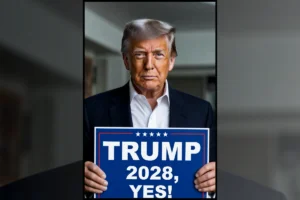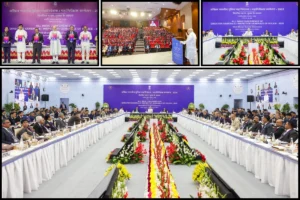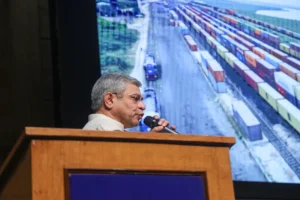
The next 10 years are very critical for the Indian economy and society as they will determine whether India can achieve its potential as a middle-income economic powerhouse or fall behind due to various challenges. India needs to sustain a growth rate of well above 7% in the next decade to leverage its favourable demography and consumption trends. However, India also faces many obstacles, such as a burgeoning population and dealing with external threats, especially from China, which has been aggressive along the border and in the region. Improving the health of the banking sector, the government’s balance sheet, and household savings are some of the other challenges facing the nation.
If India can overcome these challenges and capitalize on its strengths, it can become the world’s third-largest economy by 2027 and double its GDP by 2031. However, if India fails to address these issues and continues to follow a ‘sleeping S-shape’ growth trajectory, it may lose its momentum and fall behind its peers. Therefore, the next 10 years are crucial for India’s economic future and social well-being
As India stands at the crossroads of its destiny, the choice of leadership becomes critical. In the fractious and polarising landscape of Indian politics, one leader emerges as a beacon of unwavering resolve, visionary thinking, and a commitment to inclusive development – Prime Minister Narendra Modi. In a political arena often marred by caste-based, region-centric, and nepotism-driven practices, Modi emerges as a leader who transcends these limitations, embodying a vision for a self-reliant and corruption-free India.
Beyond Caste and Regional Politics: Unity in Diversity
In a nation as culturally and religiously diverse as India, divisive politics often takes center stage, but Modi’s approach has been one of fostering unity in diversity. Right from his days as the chief minister of Gujarat, his policies are not tailored to cater to specific castes or regions; instead, they aim to benefit the entire nation, fostering a sense of national pride and togetherness. Modi has consistently advocated for a united and harmonious India. In his addresses to the nation, Modi often quotes the Sanskrit phrase “Vasudhaiva Kutumbakam,” which means “the world is one family.” This reflects his vision of a harmonious India where everyone, regardless of their caste, religion, or socioeconomic status, feels a sense of belonging.
The Unifying Force
While other politicians often exploit caste fault lines for electoral gains, Modi’s leadership is marked by a refusal to play into divisive narratives. He recognizes that a united India is a stronger India and consistently advocates for policies that uplift all citizens, regardless of their background. His emphasis on Sabka Saath, Sabka Vikas (Development for All) is not just a slogan but a guiding principle that underlines his commitment to a cohesive and integrated nation.
A Crusade Against Corruption
The regional political landscape is particularly rife with nepotism and corruption. However, PM Modi stands out as a crusader against these vices. The initiation of bold reforms such as demonetization, and the implementation of the Goods and Services Tax (GST) were not just policy measures but a clear message that corruption would not be tolerated. By attacking the roots of corruption, Modi has shown a dedication to cleansing the system for the benefit of all citizens.
His government has taken several major steps to root out corruption:
- Setting up a Special Investigation Team (SIT): As its first cabinet decision, the government set up a court-monitored SIT which detected black money of more than Rs. 70,000 crores, including Rs. 16,000 thousand crores in offshore accounts.
- Demonetisation: The demonetisation policy introduced on November 8, 2016, was primarily aimed at rooting out black money and counterfeit currency from the Indian economy. The policy involved the sudden withdrawal of ₹500 and ₹1,000 notes from circulation, which were the main form of holding unaccounted wealth or “black money” for corrupt politicians, bureaucrats, and businessmen. The move also brought more transactions under the formal economy, thereby increasing tax compliance.
- Enacting the Black Money Act, 2015: This Act allows a penalty up to 90% of the value of an undisclosed asset in addition to tax at 30%, as well as rigorous imprisonment in certain cases.
- Strengthening the Double Tax Avoidance Agreement (DTAA): The government renegotiated tax treaties with various countries to curb treaty abuse, tax evasion and round-tripping of funds.
- Signing a Joint Declaration on the Automatic Exchange of Information (AEOI) on tax matters with Switzerland: This ensures that India will receive information on accounts held by Indian residents in Switzerland on an automatic basis.
- Enacting the Benami Transactions (Prohibition) Amendment Act, 2016: This enables confiscation of Benami property and prosecution of Benamidar and the beneficial owner.
- Implementing Direct Benefit Transfer initiative: This ensures the disbursement of welfare benefits directly to the citizens in a transparent manner.
- Implementing E-tendering in public procurements and introducing e-Governance: These measures simplify procedures and systems.
These steps reflect the Modi government’s multi-pronged approach to combating corruption and black money
Meritocracy Over Nepotism
Modi’s leadership is a testament to his belief in meritocracy. Unlike other leaders who often favor family members or close associates for key positions, Modi places emphasis on skills, competence, and a commitment to public service. This approach ensures that those in positions of power are there based on merit, fostering a culture where talent is recognized and nurtured.
Balancing Minority Empowerment and Non-Appeasement
Holistic Empowerment
One of the noteworthy aspects of Modi’s governance is his ability to strike a delicate balance between minority empowerment and non-appeasement. His policies go beyond mere tokenism, focusing on holistic development for minorities. Initiatives such as skill development programs, educational reforms, and economic opportunities are geared towards empowering minorities in a substantive and lasting manner.
Rejecting Appeasement Politics
While some leaders resort to appeasement-based politics to garner support from specific communities, Modi takes a principled stand against such practices. He understands that true empowerment lies in providing equal opportunities and facilities to all citizens, irrespective of their religious or ethnic background. His commitment to a secular and inclusive India is reflected in policies that prioritize development over divisive identity politics.
Equal Political and Economic Rights for All
Modi’s vision for India encompasses comprehensive economic empowerment. Prime Minister Narendra Modi has achieved many feats in his 9 years of governance, such as: implementing the Goods and Services Tax (GST), which simplified the tax system and boosted the ease of doing business, enacting the Insolvency and Bankruptcy Code (IBC), which helped banks recover bad loans and improved the financial health of the corporate sector, distributing free LPG cylinders to poor households under the Ujjwala scheme, which reduced indoor air pollution and improved the health of women and children and building more than four crore houses under the PM Awas Yojana (PMAY), which provided affordable housing to the urban and rural poor.
Initiatives like ‘Make in India’ and ‘Digital India’ are not just slogans but strategic plans to propel India into becoming a global economic powerhouse. By fostering economic growth, Modi aims to create a rising tide that lifts all boats, ensuring that the benefits of development reach every corner of the nation.
Electoral and Political Reforms
In pursuit of equal political rights for all, Modi has championed electoral and political reforms. Efforts to promote transparency in political funding, reduce corruption in elections, and empower grassroots democracy reflect a commitment to building a political system that is truly representative and accountable to the people.
Inclusive Leadership: Listening to the Voices of the People
Modi’s leadership style is characterized by inclusivity. Unlike some leaders who adopt a top-down approach, Modi actively seeks input from citizens across the country. Town hall meetings, interactions with the youth, and engagement with various sectors of society demonstrate a leader who listens to the concerns and aspirations of the common people.
Diverse Perspectives
Inclusive leadership, for Modi, means incorporating diverse perspectives into policy formulation. He recognizes the richness that diversity brings to a nation and ensures that policies resonate with the needs of the entire population. This approach not only strengthens democracy but also ensures that the government is attuned to the pulse of the nation.
Conclusion
As India steps into a new decade, the choice of leadership assumes paramount importance. In Narendra Modi, India finds a leader who rises above the shortcomings that often afflict other politicians. His unwavering commitment to unity, development, and inclusive governance sets him apart. Modi’s leadership is not just about the present; it is about laying the foundation for a future where every Indian, regardless of caste, creed, or background, can aspire to and achieve their dreams. As the architect of India’s destiny, Narendra Modi stands as the best choice to lead the nation over the next decade, steering it towards a future marked by progress, prosperity, and unparalleled unity.



















